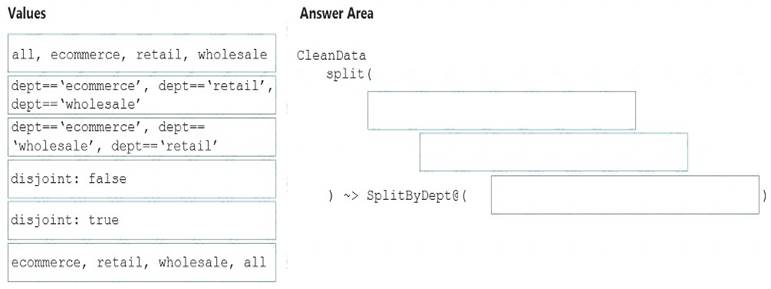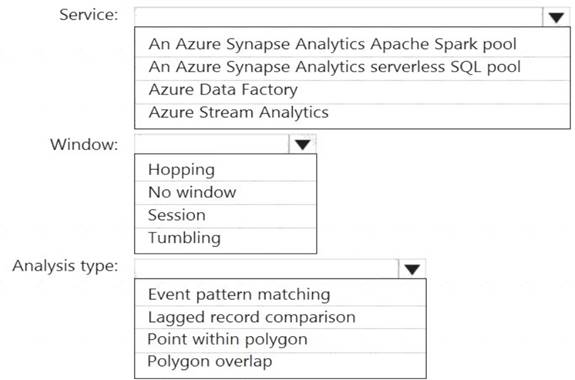- (Exam Topic 3)
You need to create an Azure Data Factory pipeline to process data for the following three departments at your company: Ecommerce, retail, and wholesale. The solution must ensure that data can also be processed for the entire company.
How should you complete the Data Factory data flowscript? To answer, drag the appropriate values to the correct targets. Each value may be used once, more than once, or not at all. You may need to drag the split bar between panes or scroll to view content.
NOTE: Each correct selection is worth one point.
Solution:
The conditional split transformation routes data rows to different streams based on matching conditions. The conditional split transformation is similar to a CASE decision structure in a programming language. The transformation evaluates expressions, and based on the results, directs the data row to the specified stream.
Box 1: dept=='ecommerce', dept=='retail', dept=='wholesale'
First we put the condition. The order must match the stream labeling we define in Box 3. Syntax:
) ~>
Box 2: discount : false
disjoint is false because the data goes to the first matching condition. All remaining rows matching the third condition go to output stream all.
Box 3: ecommerce, retail, wholesale, all Label the streams
Reference:
https://docs.microsoft.com/en-us/azure/data-factory/data-flow-conditional-split
Does this meet the goal?
Correct Answer:
A
- (Exam Topic 3)
You are designing a monitoring solution for a fleet of 500 vehicles. Each vehicle has a GPS tracking device that sends data to an Azure event hub once per minute.
You have a CSV file in an Azure Data Lake Storage Gen2 container. The file maintains the expected geographical area in which each vehicle should be.
You need to ensure that when a GPS position is outside the expected area, a message is added to another event hub for processing within 30 seconds. The solution must minimize cost.
What should you include in the solution? To answer, select the appropriate options in the answer area.
NOTE: Each correct selection is worth one point.
Solution:
Box 1: Azure Stream Analytics Box 2: Hopping
Hopping window functions hop forward in time by a fixed period. It may be easy to think of them as Tumbling windows that can overlap and be emitted more often than the window size. Events can belong to more than one Hopping window result set. To make a Hopping window the same as a Tumbling window, specify the hop size to be the same as the window size.
Box 3: Point within polygon Reference:
https://docs.microsoft.com/en-us/azure/stream-analytics/stream-analytics-window-functions
Does this meet the goal?
Correct Answer:
A
- (Exam Topic 3)
You have an Azure Synapse Analytics dedicated SQL pool that contains a large fact table. The table contains 50 columns and 5 billion rows and is a heap.
Most queries against the table aggregate values from approximately 100 million rows and return only two columns.
You discover that the queries against the fact table are very slow. Which type of index should you add to provide the fastest query times?
Correct Answer:
B
Clustered columnstore indexes are one of the most efficient ways you can store your data in dedicated SQL pool.
Columnstore tables won't benefit a query unless the table has more than 60 million rows. Reference:
https://docs.microsoft.com/en-us/azure/synapse-analytics/sql/best-practices-dedicated-sql-pool
- (Exam Topic 3)
You are designing database for an Azure Synapse Analytics dedicated SQL pool to support workloads for detecting ecommerce transaction fraud.
Data will be combined from multiple ecommerce sites and can include sensitive financial information such as credit card numbers.
You need to recommend a solution that meets the following requirements:  Users must be able to identify potentially fraudulent transactions.
Users must be able to identify potentially fraudulent transactions. Users must be able to use credit cards as a potential feature in models.
Users must be able to use credit cards as a potential feature in models.  Users must NOT be able to access the actual credit card numbers.
Users must NOT be able to access the actual credit card numbers.
What should you include in the recommendation?
Correct Answer:
C
Use Always Encrypted to secure the required columns. You can configure Always Encrypted for individual database columns containing your sensitive data. Always Encrypted is a feature designed to protect sensitive data, such as credit card numbers or national identification numbers (for example, U.S. social security numbers), stored in Azure SQL Database or SQL Server databases.
Reference:
https://docs.microsoft.com/en-us/sql/relational-databases/security/encryption/always-encrypted-database-engine
- (Exam Topic 3)
You have an Azure Data Lake Storage Gen2 container.
Data is ingested into the container, and then transformed by a data integration application. The data is NOT modified after that. Users can read files in the container but cannot modify the files.
You need to design a data archiving solution that meets the following requirements:  New data is accessed frequently and must be available as quickly as possible.
New data is accessed frequently and must be available as quickly as possible. Data that is older than five years is accessed infrequently but must be available within one second when requested.
Data that is older than five years is accessed infrequently but must be available within one second when requested. Data that is older than seven years is NOT accessed. After seven years, the data must be persisted at the lowest cost possible.
Data that is older than seven years is NOT accessed. After seven years, the data must be persisted at the lowest cost possible. Costs must be minimized while maintaining the required availability.
Costs must be minimized while maintaining the required availability.
How should you manage the data? To answer, select the appropriate options in the answer area. NOTE: Each correct selection is worth one point
Solution:
Box 1: Move to cool storage Box 2: Move to archive storage
Archive - Optimized for storing data that is rarely accessed and stored for at least 180 days with flexible latency requirements, on the order of hours.
The following table shows a comparison of premium performance block blob storage, and the hot, cool, and archive access tiers.
Reference:
https://docs.microsoft.com/en-us/azure/storage/blobs/storage-blob-storage-tiers
Does this meet the goal?
Correct Answer:
A

